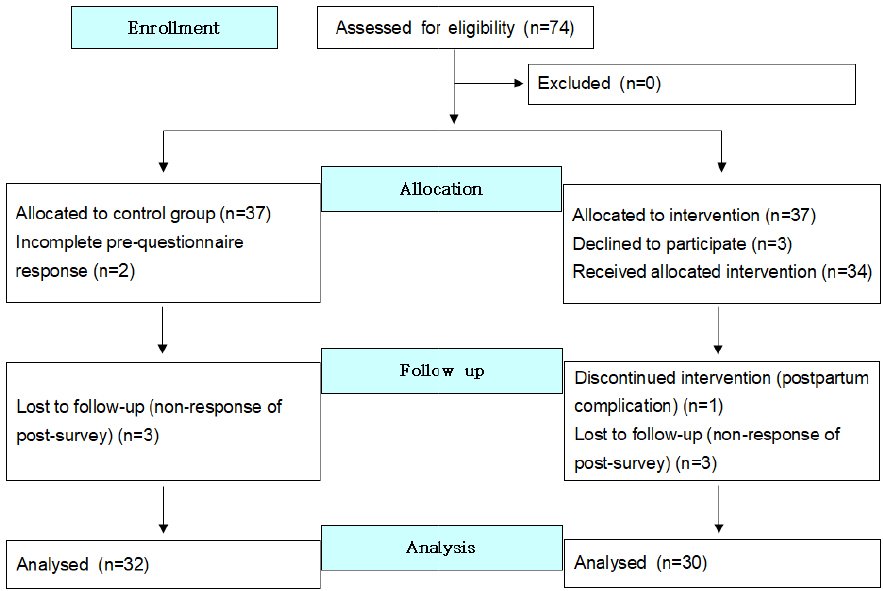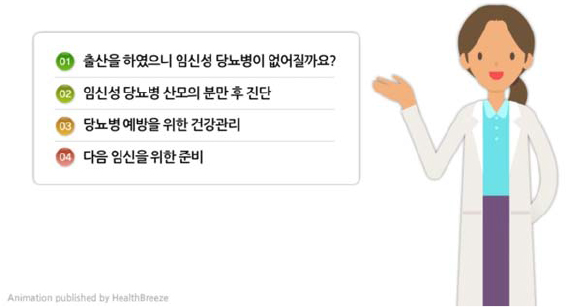Effects of a Postnatal Care Program on Self-efficacy, Self-management, and Glycemic Control in Women with Gestational Diabetes Mellitus
- Affiliations
-
- 1Nurse, Samsung Medical Center, Seoul, Korea.
- 2Unit Manager, Samsung Medical Center, Seoul, Korea.
- 3Assistant Professor, College of Nursing, Konyang University, Daejeon, Korea. nkorn91@konyang.ac.kr
- KMID: 2429688
- DOI: http://doi.org/10.4069/kjwhn.2018.24.4.367
Abstract
- PURPOSE
To examine effects of a postnatal care program on self-efficacy, self-management, and glycemic control in women with gestational diabetes mellitus (GDM).
METHODS
A non-equivalent control group non-synchronized quasi-experimental design was used. Sixty-two women with GDM were enrolled and assigned to either an experimental group (n=30) or a control group (n=32). The experimental group received an intervention which was postnatal care program for women with GDM. The postnatal care program for GDM included an individual education with leaflet and mobile web-based video with three times of telephone counseling. Effects of the intervention were measured with self-efficacy, self-management questionnaire, and a 75 g oral glucose tolerance test (75g OGTT). Statistical significance was examined using independent t-test and χ2-test.
RESULTS
Although there was no significant difference in 75g OGTT (χ2=.11, p=.748) or self-management (t=−1.28, p=.206), there was a statistically significant increase in self-efficacy (t=−2.02, p=.048) in the experimental group compared to that in the control group.
CONCLUSION
A postnatal care program is needed for women with GDM to improve their self-efficacy. Further studies are warranted to improve self-management and glycemic control through tailored education for GDM postpartum women.
MeSH Terms
Figure
Cited by 3 articles
-
The effects of health care programs for gestational diabetes mellitus in South Korea: a systematic review
Seo Jin Park, Jina Lee
Korean J Women Health Nurs. 2020;26(4):274-284. doi: 10.4069/kjwhn.2020.10.28.Psychosocial support interventions for women with gestational diabetes mellitus: a systematic review
Seulgi Jung, Yoojin Kim, Jeongok Park, Miyoung Choi, Sue Kim
Korean J Women Health Nurs. 2021;27(2):75-92. doi: 10.4069/kjwhn.2021.05.13.Do depression, anxiety, emotional intelligence, and sleep quality affect diabetes management self-efficacy in Korean women with gestational diabetes in pregnancy?: a descriptive correlational study
Hoon Ah Lee, Keum Seong Jang
Korean J Women Health Nurs. 2021;27(4):358-367. doi: 10.4069/kjwhn.2021.11.27.
Reference
-
1. Hunt KJ, Schuller KL. The increasing prevalence of diabetes in pregnancy. Obstetrics and Gynecology Clinics of North America. 2007; 34(2):173–199. DOI: 10.1016/j.ogc.2007.03.002.
Article2. Jang HC, Cho YM, Park KS, Kim SY, Lee HK, Kim MY, et al. Pregnancy outcome in Korean women with gestational diabetes mellitus diagnosed by the carpenter-coustan criteria. Journal of Korean Diabetes Association. 2004; 28(2):122–130.3. Ferrara A. Increasing prevalence of gestational diabetes mellitus: A public health perspective. Diabetes Care. 2007; 30(2):141–146. DOI: 10.2337/dc07-s206.
Article4. American Diabetes Association. Management of diabetes in pregnancy. Diabetes Care. 2017; 40:Supplement 1. S114–S119. DOI: 10.2337/dc17-S016.5. Kim C, Newton KM, Knopp RH. Gestational diabetes and the incidence of type 2 diabetes: a systematic review. Diabetes Care. 2002; 25(10):1862–1868.
Article6. Shah BR, Lipscombe LL, Feig DS, Lowe JM. Missed opportunities for type 2 diabetes testing following gestational diabetes: A population-based cohort study. BJOG: An International Journal of Obstetrics and Gynecology. 2011; 118(12):1484–1490. DOI: 10.1111/j.1471-0528.2011.03083.x.
Article7. Cho GJ, An JJ, Choi SJ, Oh SY, Kwon HS, Hong SC, et al. Postpartum glucose testing rates following gestational diabetes mellitus and factors affecting testing non-compliance from four tertiary centers in Korea. Journal of Korean Medical Science. 2015; 30(12):1841–1846. DOI: 10.3346/jkms.2015.30.12.1841.
Article8. Lee SS, Park JS, Lee SY, Oh MA, Choi HJ, Song MY. The 2015 national survey on fertility and family health and welfare. Korea Institute for Health and Social Affairs;2016. p. 201–204.9. Lee SY. Prenatal and postnatal care and its policy implications. Health and Welfare Policy Forum. 2016; 236:37–50.10. Rosenstock IM. The health belief model and preventive health behavior. Health Education Monographs. 1974; 2(4):354–386. DOI: 10.1177/109019817400200405.
Article11. Kim SS, Paek KS. Compliance with sick-role behavior and health beliefs according to the level of knowledge in diabetic patients. The Kyungpook University Medical Journal. 1991; 32(4):523–533.12. Kim C, McEwen LN, Piette JD, Goewey J, Ferrara A, Walker EA. Risk perception for diabetes among women with histories of gestational diabetes mellitus. Diabetes Care. 2007; 30(9):2281–2286. DOI: 10.2337/dc07-0618.
Article13. Kaiser B, Jeannot E, Razurel C. Determinants of health behaviors after gestational diabetes mellitus: a prospective cohort study in Geneva. Journal of Midwifery & women's health. 2016; 61(5):571–577. DOI: 10.1111/jmwh.12486.
Article14. Kaiser B, Razurel C. Determinants of postpartum physical activity, dietary habits and weight loss after gestational diabetes mellitus. Journal of Nursing Management. 2013; 21(1):58–69. DOI: 10.1111/jonm.12006.
Article15. Kaiser B, Razurel C, Jeannot E. Impact of health beliefs, social support and self-efficacy on physical activity and dietary habits during the post-partum period after gestational diabetes mellitus: study protocol. BMC Pregnancy and Childbirth. 2013; 13:133. DOI: 10.1186/1471-2393-13-133.
Article16. Bandura A, Walters RH. Social learning theory. New York, NY: General Learning Press;1977. p. 46.17. Paek KS. The development of a self-efficacy tool for diabetes millitus patient [dissertation]. Daegu: Kyungpook National University;1997. 108.18. O'Reilly SL. Prevention of diabetes after gestational diabetes: better translation of nutrition and lifestyle messages needed. Healthcare (Basel). 2014; 2(4):468–491. DOI: 10.3390/healthcare2040468.19. Kim YO. A hypothesized model for self-care behavior in diabetic patients: Based on stress-coping model [dissertation]. Seoul: Yonsei University;1997. 170.20. Kim HS. Effects of an integrated self-management program on self-management, glycemic control, and maternal identity in women with gestational diabetes mellitus [dissertation]. Seoul: Yonsei University;2011. 158.21. Horsager R, Roberts S, Rogers V, Santiago-Muñoz P, Worley K, Hoffman B. Williams obstetrics study giude. 24th ed. New York, NY: McGraw-Hill Education;2014. p. 448.22. Kim YM, Kim MY, Kwon YK, Kim HS, Park SH, Chun MS, et al. Effects of a discharge education program using computerized animation video for post-operative colon cancer patients. The Korean Journal of Rehabilitation Nursing. 2013; 16(1):37–46. DOI: 10.7587/kjrehn.2013.37.
Article23. Jung MY, Hong IK, Noh HY, Park HS, Son JM, Kim JH, et al. Effects of video-based information provision on anxiety and education satisfaction of thyroid cancer patients undergoing radio-iodine treatment. Journal of Korean Clinical Nursing Research. 2015; 21(1):11–20. DOI: 10.14371/QIH.2017.23.1.43.24. Fishman DJ. Telemedicine-bringing the specialist to the patient. Nursing management. 1997; 28(7):30–32.25. Kim YS, Kim HS, Kim YL. Effects of a web-based self-management program on the behavior and blood glucose levels of women with gestational diabetes mellitus. Telemedicine Journal and e-Health: the Official Journal of the American Telemedicine Association. 2018; Forthcoming. DOI: 10.1089/tmj.2017.0332.
Article26. Ko JM, Lee JK. Effects of a coaching program on comprehensive lifestyle modification for women with gestational diabetes mellitus. Journal of Korean Academy of Nursing. 2014; 44(6):672–681. DOI: 10.4040/jkan.2014.44.6.672.
Article27. Baek ES, Park HJ. Effects of a case management program on self-efficacy, depression and anxiety in pregnant women with gestational diabetes mellitus. Korean Journal of Women Health Nursing. 2013; 19(2):88–98. DOI: 10.4069/kjwhn.2013.19.2.88.
Article28. Khatun F, Lee TW, Rani E, Biswash G, Raha P, Kim S. The relationships among postpartum fatigue, depressive mood, self-care agency, and self-care action of first-time mothers in Bangladesh. Korean Journal of Women Health Nursing. 2018; 24(1):49–57. DOI: 10.4069/kjwhn.2018.24.1.49.
Article29. Ahn S. Postpartum Health: A comparison of mothers with preterm infants and mothers with full-term infants. Korean Journal of Women Health Nursing. 2002; 8(1):7–19.
Article
- Full Text Links
- Actions
-
Cited
- CITED
-
- Close
- Share
- Similar articles
-
- Effects of a Case Management Program on Self-efficacy, Depression and Anxiety in Pregnant Women with Gestational Diabetes Mellitus
- Effects of an Integrated Self-Management Program on Self-Management, Glycemic Control, and Maternal Identity in Women with Gestational Diabetes Mellitus
- Nutrition Care in Gestational Diabetes Mellitus
- Effect of Diabetes Education Program on Glycemic Control and Self Management for Patients with Type 2 Diabetes Mellitus
- An Adequate Intake of Carbohydrates for Gestational Diabetes Mellitus



